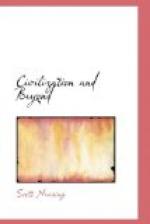During the Era of the Caesars Rome became the Eurasian-African honey pot. Wealth centered there. Authority was enthroned there. Power was generated there. Throughout the sphere of Roman political influence, of trade and travel, the central position of Rome was recognized and acknowledged. Not only knowledge and authority, but folklore mushroomed, with Rome as its central theme. Asian nomads, searching for grass, Asian potentates seeking new worlds to conquer and plunder, heard of Rome and finally went there. All roads led to Rome. Thousands of miles of stone roads were built as binding forces to hold the Empire together and defend it against all possible enemies. It was along these roads that the legions marched as they pushed back potential invaders and extended the frontiers. It was these same roads and bridges that made easy and sure the advance of the Asian hordes that would one day occupy and loot the home city. Roads and bridges enabled Roman authority to maintain and extend itself. The same roads and bridges provided a freeway that led into the citadel of Roman power.
Under the Caesars the Roman Empire achieved its greatest geographical extent and exercised its widest cultural influence. The city of Rome was the capital of the western world. There was one state, one law, one economy, one official language, one military authority.
Despite its apparent massiveness, Roman civilization was not a monolith. Rather it was a conglomerate, consisting of many parts held together by connecting social tissues which Rome and Italy alone supplied. In the first instance there was a division into provinces, colonies and newly acquired territories. The provinces, under their Roman appointed governors, enjoyed a large measure of economic and cultural self-determination within the Roman Empire. Beyond the Roman Empire lay territories and peoples associated with Rome by treaties, bound to Rome by trade and travel, in some cases paying tribute to Rome, but enjoying sufficient autonomy as peoples, nations and empires maneuvering for position and advantage, frequently allying themselves with non-Roman areas and occasionally conspiring to by-pass Roman authority and even to challenge Roman supremacy.
This political diversity along the defense perimeter of the Roman Empire existed in a chaos ranging from questioned authority to open defiance and military challenges to Rome and the threat of Romanization. Along this defense perimeter were stationed the legions that guarded the frontiers. Across it moved trade, travel, incursions, invasions and periodic reprisals as a result of which the more turbulent neighbors were brought within the sphere of Rome’s influence or, in cases of extreme dissidence and resistance, were depopulated, colonized and added to the Roman conglomerate.
It goes without saying that the influence of Roman culture extended far beyond the Roman defense perimeter, reaching peoples, nations and empires to which Rome was little more than a name. The no-man’s land between what-was and what-was-not Rome not only existed in a state of perpetual uncertainty, but provided a battle field for the smuggling, brigandage, the periodic border clashes, the migrations, incursions, invasions and punitive expeditions that are the characteristic features of every ill-defined political boundary.




